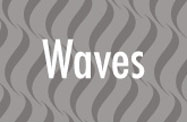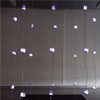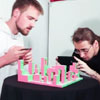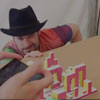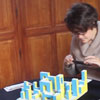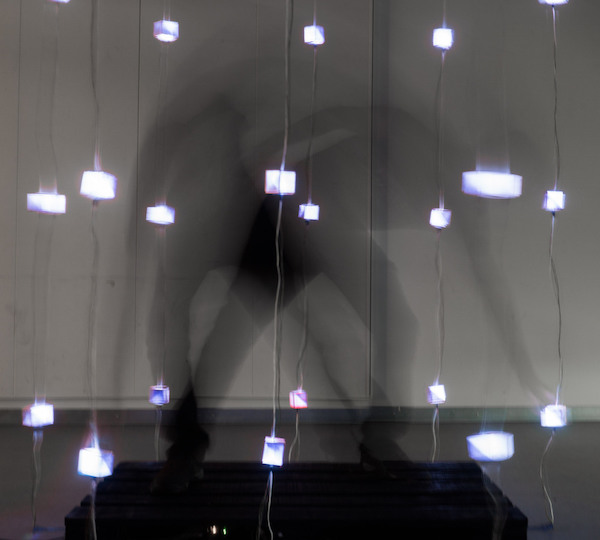
“hors-affichage.” is a game installation that questions the way video games are traditionally displayed opposing planar vs volumetric displays. It is based on deconstruction and questions the way video games are traditionally displayed and thus challenging the space in which video games can be deployed. The gameplay of hors-affichage resides in the tension between the visible and the invisible, the reachable and the unreachable. Forcing the player to enter a state of chase where he is constantly on the move and in the look out for the elements outside his field of view.

About The Artist
Lothario Areski is originally from Mexico and studied at the Institut de Creation et Animation Numériques in Paris, where he did his bachelor degree in game design and started his masters in experimental game design. After a year he decided to continue his masters at the Royal Danish Academy of Fine Arts in Copenhagen. In Paris, he worked as game and level designer at Darjeeling productions, in the games “Californium” and “Homo Machina”. Before that, he was a game and level design intern at Playtouch, a F2P mobile studio. Currently he is creating artistic game installations, some of which have been or will be exibited in a number of countries, including France, Germany, England, Denmark, USA and Mexico.
Skills Applied
 ARDUINO/ INTERACTIVE DESIGN
ARDUINO/ INTERACTIVE DESIGN
 SYSTEMS DESIGN
SYSTEMS DESIGN
 CODING
CODING
Message From The Artist
“We live in extremely confusing times, as a young adult making sense of all the things that surround us often feels like a massive tornado-earthquake-tsunami of confusing, contradicting and ultimately meaningless gibberish. However, I have found in games and art my response to nihilism. Both of them reflect, represent, and reference the world we live in, but despite it they remain autotelic. Their separateness from the “real” world may seem as an escape, but it’s only through the creation of these experiences that I have found concrete personal answers to questions too complex to answer by only looking outside myself. The answers I have found and their application, fall in one of two of categories of action, observation and play. Observation is perhaps the most incredible senses we have, it allows us to create a mental model of our surroundings. A well trained observer can find novelty in even the most familiar of objects or circumstances, constantly renovating his experiences.By contrast, playing is the action of experimenting and learning, it is an insatiable source of joy, competition, cooperation and compromise, there is play everywhere, for the ones that know how to entice it. I turn to these activities whenever everything seems too confusing, and I would urge anyone to do the same, observe better, play more and create, the world will make more sense.” Lothario Peon de Shuyter
Stemarts Design Tool
The Stemarts Design Tool provides a step-by-step tool to help you come up with a design concept for an installation or sculpture inspired by the work of Paseo artists. Explore the artist’s work and theme to understand what makes it unique. Research the science and technology behind the art to inform your design. Then experiment with the related hands-on activities and tools provided in the STEAM wiki to better understand the artist techniques and process. Finally, Brainstorm with your peers to come up with ideas, and create an Installation Design Concept to share with your school. This tool will take you through each stage of the process. Just click on Explore to get started!
Explore Gaming and motion in Space to create an interactive experience.
Lothario Peon de Schuyter combines gaming and motion in space to explore the tension between the visible and the invisible, the reachable and the unreachable. In his installation, hors-affichage, the player is constantly on the move and on the look out for the elements outside his field of view, challenging our perception. In this activity we invite you to come up with a Design Concept for an installation that applies game design to a physical interactive space, around the festival theme of connection. The first step is to explore the artist videos and STEAM wikis below, and search online, to better understand game design and how it can be applied to designing an installation. Think about games that you like to play and imagine how they might look of you turned it into an installation. Make a note of any installations that you like or do not like. At the end of the exploration review all your selections and reflect on the aspects of the design that you would like to investigate further.
Research the science and technology behind the work.
The next step is to check out the STEAM wiki below with artist suggested links to learn about game design, the science of perception, motion sensors and technologies that can be applied to enhance the interactive experience. What can you learn from these resources and the artist’s process? Even though this project does not require building the installation, it is still important to have an understanding of how they technology works in order to get ideas.
Brainstorm and experiment to see what’s possible.
Once you have identified the type of genre/installation that you resonated with and have gotten inspired by the possibilities you can start brainstorming on ideas for your own interactive installation. Hone in on some game ideas that you want to focus on and start trying them out with your team to see how they feel. Are they challenging? exciting? Boring? Start sketching out concepts and jotting down notes with ideas for an installation. Don’t try to edit at this point. Start a sketchbook just for this project and write or draw anything that comes to mind. This is where you let your imagination run wild!
Get Feedback and iterate.
This is the time to share your concept with peers and experts to get feedback and see how you can improve your design. Practice describing your concept. Discuss and listen to other people’s ideas and remain open to all new possibilities. There will be a lot of trial and error until you arrive at the final design. This stage is especially important to be sure your technical or engineering ideas are feasible. Check our Feedback Tool for some tips.
Create a design concept for an interactive game in space installation.
The next step is to do a final drawing that communicates your design for an interactive water and light installation. This could be done by hand or on a computer. The design should show what it will look like and the materials and technology you would use. It would consider possible sites and how people would interact with it. It can include diagrams, text, photos or anything you like. Most importantly it would show how your interactive installation explores the festival theme of connection. Since an installation is multidimensional you will have to find a unique and creative way to communicate your installation concept.
Share your concepts with your classmates and with the visiting artist.
Once all the student drawings are complete they can be displayed in your school. It is fascinating to see the many different ideas and solutions. You can learn a lot by noticing different design approaches and you can share them with the artist when they visit the school. Have fun and don’t forget to share your work with us in the form of photos or videos! We would love to see what you learned.
STEMarts Wiki
The STEAM-wiki is a place to get started with your artist research. You will find links to articles, images, video, and tutorials that relate to Lothario Areski’s work.
You can search by clicking on the links below or you can click on the topic words in the word cloud for specific areas of interest. For example, EXPERIMENTAL GAME DESIGN to learn about this field of study. If you are looking for STEM + Art activities type in STEAM Activities. To view all options, use the keyword ALL.
Remember the resource is an open forum sharing links and ideas that others have found – always check your sources and give credit where credit is due. The open source movement generously shares its knowledge and relies on user feedback – so if there’s something really good or doesn’t work let others know.
Accessibility arduino artists art term Bio-Sensors body awareness brain capacitive touch capactive touch circuit conductive paint conductivity connections design challenge digital art electrical field experiment experimental game design experimental game installation experimental games game design games gesture hack installation art interaction interactive interactivity interface light marine science medium motion movement ocean Paseo artists perception perception of motion physics pressure problem solving process project projection mapping proximity public art real-world problem solving rhythm senses sensor sensors sound spatial awareness systems thinking technology tutorial user interaction user interface View All vision

